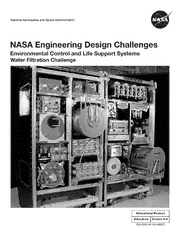
ERIC ED511738: NASA Engineering Design Challenges: Environmental Control and Life Support Systems. Water Filtration Challenge. EG-2008-09-134-MSFC PDF
Preview ERIC ED511738: NASA Engineering Design Challenges: Environmental Control and Life Support Systems. Water Filtration Challenge. EG-2008-09-134-MSFC
National Aeronautics and Space Administration NASA Engineering Design Challenges Environmental Control and Life Support Systems Water Filtration Challenge Educational Product Educators Grades 5–8 EG-2008-09-134-MSFC Cover Image: This is a close-up view of the Environmental Control and Life Support System (ECLSS) Water Recovery System (WRS) racks. The WRS provides clean water through the reclamation of wastewaters, including water obtained from the Space Shuttle’s fuel cells, crewmember urine, used hand wash and oral hygiene water, cabin humidity condensate, and extravehicular activity (EVA) wastes. NASA Engineering Design Challenges Environmental Control and Life Support Systems Water Filtration Challenge National Aeronautics and Space Administration NASA Marshall Space Flight Center Science and Technology Directorate: Research Planning and Integration Office Environmental Control and Life Support System (ECLSS) Division Academic Affairs Office NASA Headquarters Exploration Systems Mission Directorate: Office of Education This publication is in the public domain and is not protected by copyright. Permission is not required for duplication for classroom use. i ii Acknowledgements Project Director/Editor Education Content Reviewers Twila Schneider, Ed.S. Julie Clift Schafer Corporation WILL Technology, Inc. Huntsville, Alabama Huntsville, Alabama Technical Advisors Dawn Mercer Robyn Carrasquillo WILL Technology, Inc. Environmental Control and Life Support Huntsville, Alabama System Division NASA Marshall Space Flight Center Vanessa Suggs Academic Affairs Office Larry Davis Elementary and Secondary Programs Avionics and Software Systems Branch NASA Marshall Space Flight Center Spacecraft and Vehicle Systems Department NASA Marshall Space Flight Center Document Design and Layout Pedro Rodriguez Randy Keen TRAX International E3 and Electrical Integration Branch Huntsville, Alabama Instrument and Payload Systems Department NASA Marshall Space Flight Center Pablo Garcia TRAX International Charlie Nola Huntsville, Alabama Avionics and Software Systems Branch Spacecraft and Vehicle Systems Department Jason Shoemate NASA Marshall Space Flight Center TRAX International Huntsville, Alabama Monsi Roman Environmental Control and Life Support Daniel Frew System Division TRAX International NASA Marshall Space Flight Center Huntsville, Alabama Todd Schneider Melissa Higdon Space Environments and Effects Branch TRAX International NASA Marshall Space Flight Center Huntsville, Alabama iii iv Organization of this Educator Guide This guide is organized into seven chapters. I. Overview II. The Design Challenge III. Connections to National Curriculum Standards IV. Preparing to Teach V. Classroom Sessions VI. Opportunities for Extension VII. Teacher Resources This Educator Guide has been set up to help you find things quickly and to minimize your need to “jump around.” In large part, you can start at the front and continue straight through to the end. Chapter I, Overview, provides information about Environmental Control and Life Support Systems used on NASA spacecraft. Chapter II, The Design Challenge, provides a brief description of the challenge, time requirements, and materials and cost estimates. A more detailed list of materials appears in chapter IV. Chapter III, Connections to National Curriculum Standards, provides correlations to the National Science Education Standards, the Standards for School Mathematics, and the Standards for Technological Literacy. Chapter IV, Preparing to Teach, contains all of the basic information you need to know, and lists everything you need to do, before using the challenge in your classroom. Chapter V, Classroom Sessions, provides information that will guide you through each session. Chapter VI, Opportunities for Extension, describes optional activities that are related to the basic challenge. These extensions are described but not actually developed for you. Chapter VII, Teacher Resources, contains useful websites, information regarding NASA’s Educator Resource Center Network, and black line masters for classroom use. v vi Table of Contents I. Overview .........................................................................................................................................................1 Introduction to Environmental Control and Life Support Systems ............................................................1 Environmental Control and Life Support on the International Space Station............................................1 Purification Process ...................................................................................................................................3 II. The Design Challenge ...................................................................................................................................7 The Challenge ............................................................................................................................................7 Time Requirements....................................................................................................................................7 Materials and Cost Estimates ....................................................................................................................7 An Inquiry-based Challenge ......................................................................................................................7 III. Connections to National Curriculum Standards ........................................................................................9 National Science Education Standards .....................................................................................................9 Standards for School Mathematics ...........................................................................................................9 Standards for Technological Literacy ......................................................................................................10 IV. Preparing to Teach.......................................................................................................................................11 Detailed Materials Lists ...........................................................................................................................11 Measuring Conductivity ...........................................................................................................................13 Directions for Building the Conductivity Tester .......................................................................................14 Directions for Making the Filtration Device ..............................................................................................15 Directions for Making Simulated Wastewater .........................................................................................16 Measuring pH ..........................................................................................................................................16 Common pH Measurements ...................................................................................................................16 Safety Considerations .............................................................................................................................16 Teaching Strategies for an Engineering Design Challenge ......................................................................17 Helping Students Understand the Design Process .................................................................................17 V. Classroom Sessions ....................................................................................................................................19 Session 1: Introduce the Challenge .........................................................................................................20 (1–2 class periods) Session 2: Design and Test a Filtration Device .......................................................................................22 (1–2 class periods) Session 3: A Filtration Device for the Class ............................................................................................25 (1–2 class periods) Session 4: Construct Posters ………………………………………………………………………………… 27 (1 class period) Session 5: Student Presentations ...........................................................................................................28 (1 class period) VI. Opportunities for Extension ........................................................................................................................29 VII. Teacher Resources ......................................................................................................................................31 Web Sites.................................................................................................................................................31 NASA Resources for Educators ..............................................................................................................31 Black Line Masters ..................................................................................................................................33 Glossary ...................................................................................................................................................42 vii viii
